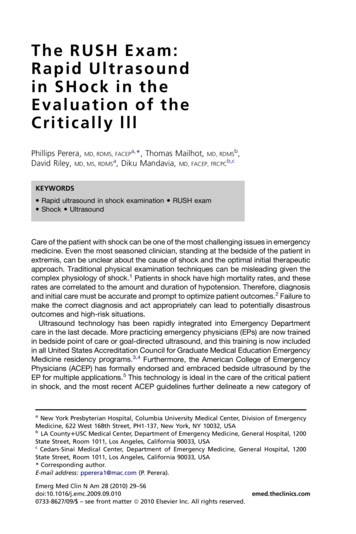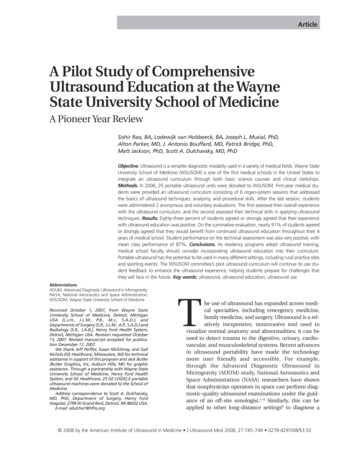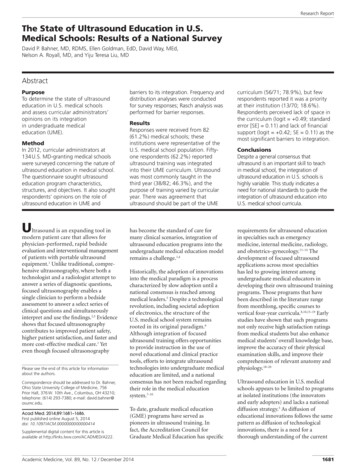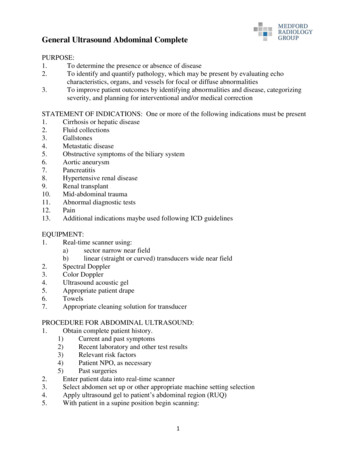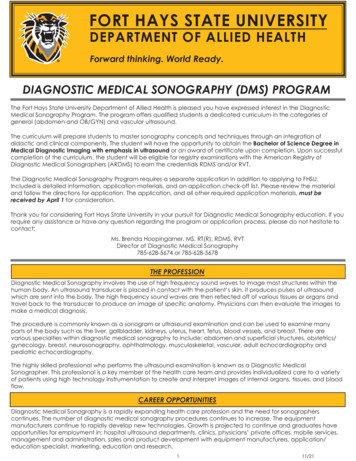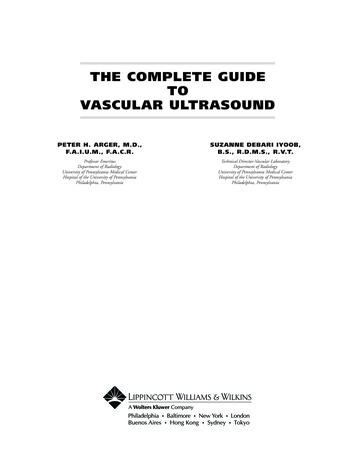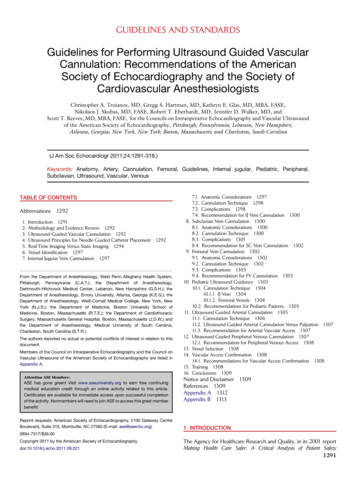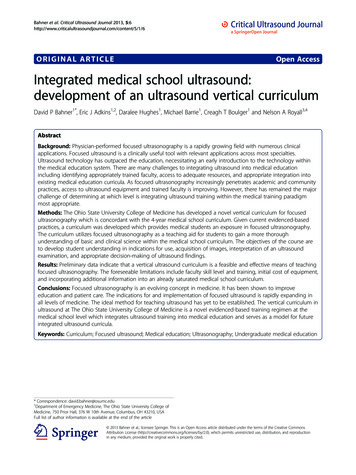
Transcription
Bahner et al. Critical Ultrasound Journal 2013, t/5/1/6ORIGINAL ARTICLEOpen AccessIntegrated medical school ultrasound:development of an ultrasound vertical curriculumDavid P Bahner1*, Eric J Adkins1,2, Daralee Hughes1, Michael Barrie1, Creagh T Boulger1 and Nelson A Royall3,4AbstractBackground: Physician-performed focused ultrasonography is a rapidly growing field with numerous clinicalapplications. Focused ultrasound is a clinically useful tool with relevant applications across most specialties.Ultrasound technology has outpaced the education, necessitating an early introduction to the technology withinthe medical education system. There are many challenges to integrating ultrasound into medical educationincluding identifying appropriately trained faculty, access to adequate resources, and appropriate integration intoexisting medical education curricula. As focused ultrasonography increasingly penetrates academic and communitypractices, access to ultrasound equipment and trained faculty is improving. However, there has remained the majorchallenge of determining at which level is integrating ultrasound training within the medical training paradigmmost appropriate.Methods: The Ohio State University College of Medicine has developed a novel vertical curriculum for focusedultrasonography which is concordant with the 4-year medical school curriculum. Given current evidenced-basedpractices, a curriculum was developed which provides medical students an exposure in focused ultrasonography.The curriculum utilizes focused ultrasonography as a teaching aid for students to gain a more thoroughunderstanding of basic and clinical science within the medical school curriculum. The objectives of the course areto develop student understanding in indications for use, acquisition of images, interpretation of an ultrasoundexamination, and appropriate decision-making of ultrasound findings.Results: Preliminary data indicate that a vertical ultrasound curriculum is a feasible and effective means of teachingfocused ultrasonography. The foreseeable limitations include faculty skill level and training, initial cost of equipment,and incorporating additional information into an already saturated medical school curriculum.Conclusions: Focused ultrasonography is an evolving concept in medicine. It has been shown to improveeducation and patient care. The indications for and implementation of focused ultrasound is rapidly expanding inall levels of medicine. The ideal method for teaching ultrasound has yet to be established. The vertical curriculum inultrasound at The Ohio State University College of Medicine is a novel evidenced-based training regimen at themedical school level which integrates ultrasound training into medical education and serves as a model for futureintegrated ultrasound curricula.Keywords: Curriculum; Focused ultrasound; Medical education; Ultrasonography; Undergraduate medical education* Correspondence: david.bahner@osumc.edu1Department of Emergency Medicine, The Ohio State University College ofMedicine, 750 Prior Hall, 376 W 10th Avenue, Columbus, OH 43210, USAFull list of author information is available at the end of the article 2013 Bahner et al.; licensee Springer. This is an Open Access article distributed under the terms of the Creative CommonsAttribution License (http://creativecommons.org/licenses/by/2.0), which permits unrestricted use, distribution, and reproductionin any medium, provided the original work is properly cited.
Bahner et al. Critical Ultrasound Journal 2013, t/5/1/6BackgroundPhysician-performed focused ultrasonography representsa novel approach to patient evaluation and treatment inthe acute and chronic settings [1]. Ultrasound has beenutilized for decades by traditional imaging specialists(radiologists, cardiologists, and obstetric-gynecologists)within the comprehensive ultrasound paradigm, inwhich a sonographer performs the examinationfollowed by a physician evaluating the images. The recentdevelopment of portable and handheld ultrasoundmachines has led to a rapid growth in an emerging fieldcalled focused ultrasonography [2]. Unlike traditionalimaging modalities, focused ultrasound is available as abedside tool which can be both performed and interpretedinstantly by the physician. Focused ultrasound hasbeen demonstrated to improve rapid diagnosis, clinicalmanagement, and procedural performance in multiplestudies [1]. As shown in Table 1, the potential usesfor focused ultrasonography are broad and crossmany specialties.In recognition of the potential role of focusedultrasound within clinical practice, the AmericanMedical Association (AMA) has affirmed that bedsidefocused ultrasound is within the scope of practice ofappropriately trained physicians [3,4]. Governing bodies forphysician specialties have also begun to define the scope ofpractice for physician-performed focused ultrasonography.For example, the American College of EmergencyPage 2 of 9Physicians (ACEP) defined the use of ultrasonographyin trauma, intrauterine pregnancy, abdominal aorticaneurysm, cardiac, biliary, urinary tract, venousthromboembolism, soft tissue, musculoskeletal, thoracic,and ocular evaluation and procedural guidance to bewithin the emergency physician's scope of practice[5,6]. Moreover, billing and reimbursement for focusedultrasound has been supported through the AMAPhysicians' Current Procedural Terminology (CPT)2011 codes which include CPT code modifiers forfocused ultrasonography [7]. Despite supporting evidence and administrative policies for physician-performedfocused ultrasonography, an educational strategy andwidely accepted guidelines for competency for focusedultrasonography have yet to be established.Integration of ultrasound into medical educationA central issue in training physicians in ultrasonographylies in locating the time and funding for trainingprograms. Initial attending-level programs providedevidence for the use of physician-performed focused ultrasonography, and participants demonstrated rapid skill acquisition and improved interpretation skills following thesecourses [8]. These courses however are generally limited tohospital-based programs or subspecialty-based educationalforums which are further limited by single-session timeconstraints and are unable to provide longitudinal trainingand ongoing skill assessment.Table 1 Currently described applications for physician-performed focused ultrasonography defined by physician specialtySpecialtyApplicationsInternal medicineHypotension evaluation and treatment, procedural guidanceCardiologyCardiac evaluation, procedural guidanceGastroenterologyLiver evaluation, intestinal obstruction evaluation, procedural guidanceInfectious diseaseSoft tissue infection evaluation, procedural guidanceNephrologyRenal evaluation, procedural guidancePulmonologyPleural effusion evaluation, atelectasis evaluation, pneumothorax evaluation, procedural guidanceRheumatologyJoint and tendon evaluation, procedural guidancePediatricsDevelopmental abnormality evaluation, abdominal pain evaluation, procedural guidanceEmergency medicineHypotension evaluation, intrauterine pregnancy evaluation, abdominal aortic aneurysm evaluation, cardiacevaluation, biliary tree evaluation, urinary tract evaluation, venous thromboembolism evaluation, soft tissueand musculoskeletal evaluation and treatment, lung evaluation, ocular evaluation, procedural guidanceObstetrics-gynecologyIntrauterine pregnancy evaluation, fetal development evaluation, ovary evaluationSurgeryTrauma evaluation, breast and thyroid evaluation, vascular evaluation, intraoperative evaluation, procedural guidanceAnesthesiaIntraoperative monitoring, procedural guidanceCritical careHypotension evaluation, intravascular volume evaluation and treatment, cardiac evaluation, lung evaluation,intracranial pressure monitoring, procedural guidanceNeurologyTranscranial evaluationNeurosurgeryTranscranial and intracranial evaluation, intraoperative guidanceOrthopedic surgeryJoint and tendon evaluation and treatment, procedural guidanceUrologyUrinary tract evaluationPlastic surgeryIntraoperative evaluation
Bahner et al. Critical Ultrasound Journal 2013, t/5/1/6Currently focused ultrasonography is a required component of Emergency Medicine, Obstetrics-Gynecology,Internal Medicine, and Radiology and recommended forGeneral Surgery and Anesthesiology residency trainingprograms [9-11]. Traditional training at the resident levelwas first pioneered through Radiology and ObstetricsGynecology, although these programs were designedto teach comprehensive ultrasonography within theirrespective areas of interest [12]. Other specialties suchas General Surgery have developed resident trainingin focused ultrasonography, in particular for evaluation andmanagement of traumatic injuries [13]. The experiencesgained in these programs vary greatly, and to date manygeneral surgeons may rely on Emergency Medicine orRadiology physicians to perform a Focused Assessmentwith Sonography in Trauma (FAST) examination.Perhaps the most advanced training programs in focusedultrasonography have come from Emergency Medicine,where residents are recommended to develop a proficiencyin 11 different ultrasound foci [9,14]. However, theserecommendations have not been accompanied by curricula,competency assessment, or a method to standardize thequality and quantity of focused ultrasound exposureacross programs. This variability between specialtiesand even residency programs demonstrates a need for acommon foundational curriculum.Role of ultrasound within medical schoolFocused ultrasonography has the potential to be both aneducational adjunct and a clinical tool for medicalstudents [15-29]. Early analyses demonstrated that insmall cohorts, medical students were able to developthe psychomotor and interpretative skills required foreffective focused ultrasonography [17,20,22,25,26,29].For example, a study at Wayne State University showedthat first-year medical students were able to successfullyutilize portable ultrasound to differentiate sonographicobjects following six 90-min sessions covering abdominal,cardiovascular, genitourinary, and musculoskeletalapplications [29]. Additional efforts have demonstratedthat focused ultrasonography may be useful as aneducational aid in teaching anatomy to medicalstudents [15,16,18,19,27]. A study from the MayoClinic demonstrated that fourth-year medical studentswho used focused echocardiography to aid in theunderstanding of cardiovascular anatomy had highsatisfaction rates [15]. Further, the use of focusedultrasonography among medical school students has beenshown to potentially aid in the development of physicalexamination skill acquisition [19,28]. In a study from theUniversity of Chicago, fourth-year medical students usedfocused echocardiography in cardiac evaluation withsubsequent improved detection of cardiac conditions andhigher accuracy in cardiac auscultation skills [19].Page 3 of 9Medical students have been shown to adequatelydevelop focused ultrasound skills for clinical practicethrough multiple small studies [21,28,30]. Despite thedemonstrated benefits, there have been only limitedefforts to develop a comprehensive and organizedcurriculum utilizing focused ultrasonography in medicalschool [28,31]. The need for a vertical curriculum whichincorporates ultrasound education into an existingmedical school curriculum was the basis for developmentof an ultrasound vertical curriculum at The Ohio StateUniversity College of Medicine (OSU COM).MethodsThe purpose of the ultrasound vertical curriculumwas to develop medical student proficiency in focusedultrasonography that would allow graduates to (1)identify appropriate uses of focused ultrasonography,(2) acquire real-time ultrasound images and video, (3)interpret ultrasound findings, and (4) utilize ultrasoundfindings in clinical decision-making. A curriculum wasdeveloped based upon three learner theory model corecomponents: cognitive, behavioral, and constructive. Dueto curriculum time constraints, the decision was made toemphasize cognitive and behavioral learning componentswithin mandatory courses and include constructivecomponents predominately within the elective orselective courses. Table 2 shows the integration of verticalultrasound curriculum components within the currentmedical school curriculum.Objectives of an integrated curriculumThe curriculum was constructed to accomplish objectiveswithin focused ultrasonography which are complimentaryto the larger medical school curriculum. Given thepredominance of basic science and clinical skills taughtduring the first 2 years of the curriculum, emphasis onultrasound basic science and image acquisition was chosen.Within the clinical years, an emphasis on ultrasoundindications and interpretation was selected.In the first medical school year, the curriculumcovered basic ultrasound physics including ultrasoundwave production, propagation within media, and imageproduction. Also, students learned how to utilize a portableultrasound machine to acquire ultrasound images andidentify basic anatomy given respective acoustic properties.In the second medical school year, students learnedadvanced ultrasound physics including variations inultrasound transducer wave production, artifact production,and thermo-mechanical heat production with a basicunderstanding of associated relative risks. Followingthe second year, students were able to understand imageacquisition limitations and methods to overcome challengesto image acquisition as well as utilize ultrasound duringbasic procedural guidance. In the third medical school year,
Bahner et al. Critical Ultrasound Journal 2013, t/5/1/6Page 4 of 9Table 2 An overview of four-year integrated vertical ultrasound curriculum developed at The Ohio State University CollegeMedical school yearComponentsMedical School Year 13 MonthsGross Anatomy andLaboratoryMusculoskeletal Anatomy UltrasoundThorax, Abdomen and Pelvis Anatomy UltrasoundHead and Neck Anatomy UltrasoundMedical School Year 2Medical School Year 3bMedical School Year 4Introduction to Focused Ultrasound Electivea7 MonthsBasic Science Curriculum2 MonthsVacation8 MonthsBasic Science CurriculumBasic Course in Focused UltrasoundProtocols Electivea2 WeeksIntroduction to Clinical MedicineUltrasound-Guided Vascular Access2 MonthsVacation8 WeeksInternal Medicine8 WeeksPediatrics8 WeeksFamily Medicine8 WeeksGeneral Surgery8 WeeksNeurology/Psychiatry6 WeeksObstetrics-Gynecology2 WeeksClinical TopicsCore Focused Ultrasound Protocols1 MonthEmergency Medicine RotationEmergency Focused Ultrasound1 MonthAmbulatory Medicine Rotation1 MonthChronic Care RotationSpecialty-Based Hands-On UltrasoundExperience1 MonthSub-Internship Rotation7 MonthsElective RotationsUltrasound Model Pool ElectiveaSpecialty-Based Hands-On Ultrasound ExperienceAdvanced Course inFocused Ultrasound ElectiveaaAn elective course which is not mandatory for students; bonly selected specialties are participated.students learned to identify general indications for specificfocused ultrasound examinations and the proper timelinein the clinical scenario for their use as well as gaininga deeper understanding of ultrasound for proceduralguidance. In the fourth medical school year, studentswere able to identify limitations of focused ultrasonographyand identify the sensitivity and specificity for focusedultrasonography for basic ultrasound protocols as wellas understand risks and benefits associated withfocused ultrasonography in clinical scenarios. Studentswere able to utilize focused ultrasonography at leastwithin the scope of practice of their chosen specialtyprior to graduation.Facilities and facultyThe OSU COM is a single-campus university-basedcollege with a university-based medical center oncampus. The OSU COM is a 4-year medical school with2,779 full-time faculty and approximately 863 students.The college curriculum is a traditional structure withtwo preclinical years of basic science and integratedclinical exposures followed by two clinical years. Thepreclinical course structure is an organ-based structure andcontains longitudinal clinical mentorship for instruction.The clinical years consist of month-long rotations withmandatory rotations in Family Medicine, InternalMedicine, Pediatrics, Surgery, Obstetrics-Gynecology,Neurology, and Psychiatry during the third year andselective rotations throughout the third year with amandatory fourth-year Emergency Medicine rotation.The medical center consists of a 1,177-bed hospitalsystem with 1,158 full-time clinical faculty in additionto residency and fellow training programs. The medicalcenter contains portable ultrasound machines available forphysician use within the Emergency Department, Surgicaland Medical Intensive Care Units, Radiology Department,and medical and surgical patient floors.The OSU COM contains a staffed simulation andtraining center (OSU COM Clinical Skills and EducationAssessment Center) containing lecture rooms, simulationlabs, and clinical rooms shared by the college and medicalcenter. The clinical skill center simulation equipmentincludes ultrasound simulation models such as vascularphantoms for ultrasound-guided vascular access andpelvic phantoms for obstetrics and gynecology ultrasound examinations. Additionally, the center containsa dedicated ultrasound practical scanning center withfour portable ultrasound machines with image andvideo archival systems.Curriculum descriptionMedical school year 1Numerous gross anatomy adjuncts exist to aid understanding anatomical relationships and serve as an introduction
Bahner et al. Critical Ultrasound Journal 2013, t/5/1/6to image comprehension. Unlike computed tomography,magnetic resonance imaging, or X-ray, ultrasoundallows for hands-on exploration of anatomy. Medicalstudents are provided 2-h-long lectures on basicultrasound principles. The lectures review ultrasoundwave production, propagation in tissue, and imageproduction in addition to portable ultrasound machineknobology, transducers, and image acquisition techniques.Students participate in 1-h supervised hands-on sessionsduring each anatomy region. Students obtain ultrasoundimages of all required anatomical relationships for therespective anatomy region. Sessions are led by theultrasound faculty and an anatomy professor. Individualguidance is provided by fourth-year medical students, andstudent volunteers serve as live models. Table 3 shows theanatomical structures and regions covered in the course.The practical anatomy examination for each anatomicalregion includes anatomy identification questions usingultrasound images and video.After gross anatomy, a supplemental course is availablefor approximately 80 students to increase hands-on timeand improve basic ultrasound education. The courseutilizes the evaluation of a hypotensive patient withfocused ultrasound as the main construct, with theestablished Trinity protocol as the primary assessmentmethod [32]. Monthly lectures and hands-on sessionsreview the basic concepts covered during the grossanatomy ultrasound course and further explain conceptssuch as ultrasound wave production, propagation in mediasuch as tissue, air, or fluid, and thermo-mechanicaleffects. The lectures explain the I-AIM model (indication,acquisition, interpretation, and medical decision-making) tostudents as a guide for utilizing focused ultrasonography[33]. Students are taught to recognize ultrasonographicfindings such as pericardial effusions, cardiac motilitydisorders, abdominal free fluid, and aortic aneurysms.A post-course examination consisting of a practicalexamination on live student models and a written imageidentification examination is held to assess proficiency.Page 5 of 9Table 3 Anatomical structures acquired and identified onlive models during the ultrasound component of grossanatomyAnatomicalregionAnatomical structureThorax andabdomenCardiac chambers (right and left ventricles,right and left atria)PericardiumInferior vena cava (intra-abdominal andintrathoracic)Diaphragmatic caval hiatusCavo-atrial junctionMain portal veinIntrahepatic portal veins (right and left)Hepatic veins (right, middle, and left)GallbladderKidney (right and left)SpleenHepatorenal recess (Morrison's pouch)Aorta (intra-abdominal)Celiac trunk, splenic artery, common hepatic artery,left gastric arterySuperior mesenteric arteryInferior mesenteric arteryRenal artery (right and left)Common iliac arteries (right and left)Upper extremitiesSupraspinatus tendonSubscapularis tendonBiceps brachii tendonFlexor digitorum profundusFlexor digitorum superficialisFlexor pollicis longusMedian nerveLower extremitiesQuadriceps muscle belly and central tendonPatellaPatellar ligamentHead and neckTracheaThyroid glandMedical school year 2Thyroid cartilageIn preparation for the transition to clinical applicationsof preclinical training, medical students at OSU COMare exposed to a 2-week hands-on clinical skill reviewsession in conjunction with a clinical reasoning course.An introduction to ultrasound-guided and ultrasoundassisted procedures is provided during the course byperforming ultrasound-guided long- and short-axisperipheral and central vascular cannulation. Students arerequired to successfully differentiate venous from arterialvasculature using B-mode, compression, Doppler, andcolor ultrasonography. Online lectures through theEMSono site, an online learning management website,provide students with introductory didactics on basicsInternal jugular veinCommon carotid arterySternocleidomastoidin ultrasound as an adjunct to hands-on training [34].Post-didactic lecture quizzes are provided to ensureadequate understanding prior to completion of thehands-on sessions. A 1-h review of the proceduralindications for ultrasound guidance and assistance aswell as potential challenges in use such as imageartifact production, site contamination, and equipmentrequirements is provided.
Bahner et al. Critical Ultrasound Journal 2013, t/5/1/6Page 6 of 9In coordination with organ-based topics during thesecond pre-clinical medical school year, an electivecourse teaching focused ultrasound examination ofrelevant organ systems is available for approximately40 students. The primary objectives of the longitudinalcourse are to provide increased exposure and review ofbasic ultrasound principles, additional focused ultrasoundprotocols, and hands-on experience with portable ultrasound machines. Basic ultrasound principles are presented,including machine operation such as patient identification,image orientation and labeling standards, and productionof images and video using secondary and tertiary functionssuch as color or power Doppler, measurements, and labels.Ultrasound protocols and organ systems covered throughthe course are shown in Table 4. Additional requiredinteractive online lectures are provided through theonline resource EMSono, reviewing the topics coveredin didactic lectures. Students record a log of ultrasoundimages and video supporting each ultrasound protocolcompleted and must perform at least five ultrasoundexaminations in each focus to meet a minimum of 25examinations. Participation as an ultrasound model isan additional educational component used for thecourse to expose students to patient-focused issues such aspatient positioning, probe pressure limitations, andanatomical limitations. Students were required to completeat least 10 hours of live ultrasound modeling as partof the course.Table 4 Organ-systems and focused ultrasound protocolscovered during elective longitudinal ultrasound coursefor second-year medical studentsMedical school year 3Students complete online lectures in focused ultrasonography using the EMSono resource prior to the initialfocused ultrasound session [34]. A 2-h didactic lecture onevidenced-based evaluation of a hypotensive patient isgiven, which includes a review of focused ultrasonographyprinciples from the previous coursework such as ultrasoundindications, acquisition, and interpretation. Studentsthen complete a faculty-led hands-on session wherestudents demonstrate an evaluation of a hypotensivepatient, including the previously described Trinityhypotensive protocol, transvaginal evaluation for pregnancy, and placement of central venous catheters underultrasound guidance. As part of the rotation, students demonstrate focused ultrasound examinations on EmergencyDepartment patients in appropriate clinical scenariosunder faculty guidance, consistent with the current ACEPultrasound scope of practice guidelines [6].Students entering specialties with demonstratedfocused ultrasonography applications are able to enrollin an elective course in advanced ultrasound training.The previously described course holds monthly didacticlectures, hands-on sessions, and journal club sessions ona specific focused ultrasound topic. Enrollment in thecourse is limited to approximately 40 students per year.Didactic sessions are 2-h lectures from specialty-specificIn the mandatory core clinical rotations during the thirdmedical school year, OSU COM students complete anadjunct course focused on enhancing their understandingof ultrasound indications and image interpretation.The third year course consists of online interactivelectures, didactic lectures, and hands-on sessions.Previously described ultrasound protocols include theTrinity hypotensive examination, FAST, cardiac evaluationduring ACLS, transvaginal pregnancy evaluation, andultrasound-guided vascular access. Students complete anonline interactive lecture through the EMSono resourceprior to the course. A 2-h didactic lecture covers specificindications for focused ultrasonography and ultrasoundimage interpretation techniques and sample images [34].Hands-on sessions then have students demonstratefocused ultrasonography in the required protocols,with an emphasis on evaluation of a clinical scenarioand ultrasound image and video interpretation.Medical school year 4In conjunction with the mandatory Emergency Medicinerotation, fourth-year students are taught to develop practicemanagement algorithms which incorporate focusedultrasonography as part of evidenced-based practices.TopicFocused ultrasoundprotocolAbdomenFASTUltrasound images/videoPerihepaticPerisplenicPericardial (subxiphoid)Recto-uterine/recto-vesicalAbdominal aorticaneurysmCeliac trunkSuperior mesenteric arteryRenal arteriesCommon iliac arteriesInferior vena cavacollapsibility indexThoracicPneumothoraxSuprahepatic IVC during expirationSuprahepatic IVC during inspirationPleural slidingM-mode pleural slidingCardiacParasternal long axisParasternal short axis (ventricleapex, middle, and base)ApicalSubxiphoidProceduralVascular accessDifferentiation of artery and veinNeedle vessel entry in short axisNeedle vessel entry in long axis
Bahner et al. Critical Ultrasound Journal 2013, t/5/1/6faculty discussing the indications, contraindications,acquisition techniques, and examination interpretationand management implications for the topic. Hands-onsessions are proctored by the ultrasound faculty withassistance from monthly faculty using volunteer studentsfor practice scanning models. Journal club sessionsuse faculty-selected journal articles on the topic withstudent-led presentation and analysis of the articles.Students participate in practical scanning experiencesduring weekly Intensive Care Unit and EmergencyDepartment ultrasound rounds. Students are evaluatedthrough monthly quizzes and final examinations withmandatory requirements for logged ultrasound examinations in each ultrasound focus. Furthermore, assignedlectures and readings are provided through the onlineresource EMSono and previously developed YouTubepresentations from OSU COM faculty.Ethical approvalEthical approval was obtained from The Ohio StateUniversity Office of Responsible Research Practicesand Institutional Review Board. The study was deemedexempt research and a waiver of informed consent wasapproved by the board for the report.Results and discussionThe major challenge to technology-focused curricularcomponents generally lies with funding. Specific to focusedultrasonography, start-up costs include obtaining portable or handheld ultrasound machines and associatedmaintenance costs. Current models for portable ultrasoundmachines can range up to US 60,000 per machineincluding service agreements and appropriate transducers.Handheld ultrasound machines may represent a drasticallyless expensive, although currently limited technologicallyoption, with some machines ranging near US 10,000including service agreements. To limit equipment costs,this program utilized shared equipment with the medicalcenter and relies upon clinical ultrasound machinesfor a large portion of the educational experience.Faculty time requirements were limited by designatinga single faculty member as the ultrasound programdirector. Additional OSU COM faculty from departmentswith established ultrasound practices and experience wereused to further enhance the program such as EmergencyMedicine, Obstetrics and Gynecology, Radiology, Surgery,and Internal Medicine.An additional issue facing new curricula is studenttime constraints and integration into existing teachingmethodologies. Ultrasound has proven benefit as a teachingaid in anatomy, physiology, and clinical diagnosis andtreatment [15,18,19,23]. Focused ultrasonography is arelatively novel teaching aid, and many faculty, evenat academic centers, may not be proficient with thePage 7 of 9technology. The purpose of this program was todemonstrate that with limited faculty experienced infocused ultrasonography, a robust and vertical ultraso
The ideal method for teaching ultrasound has yet to be established. The vertical curriculum in ultrasound at The Ohio State University College of Medicine is a novel evidenced-based training regimen at the medical school level which integrates ultrasound training into medical education and serves as a model for future integrated ultrasound .
